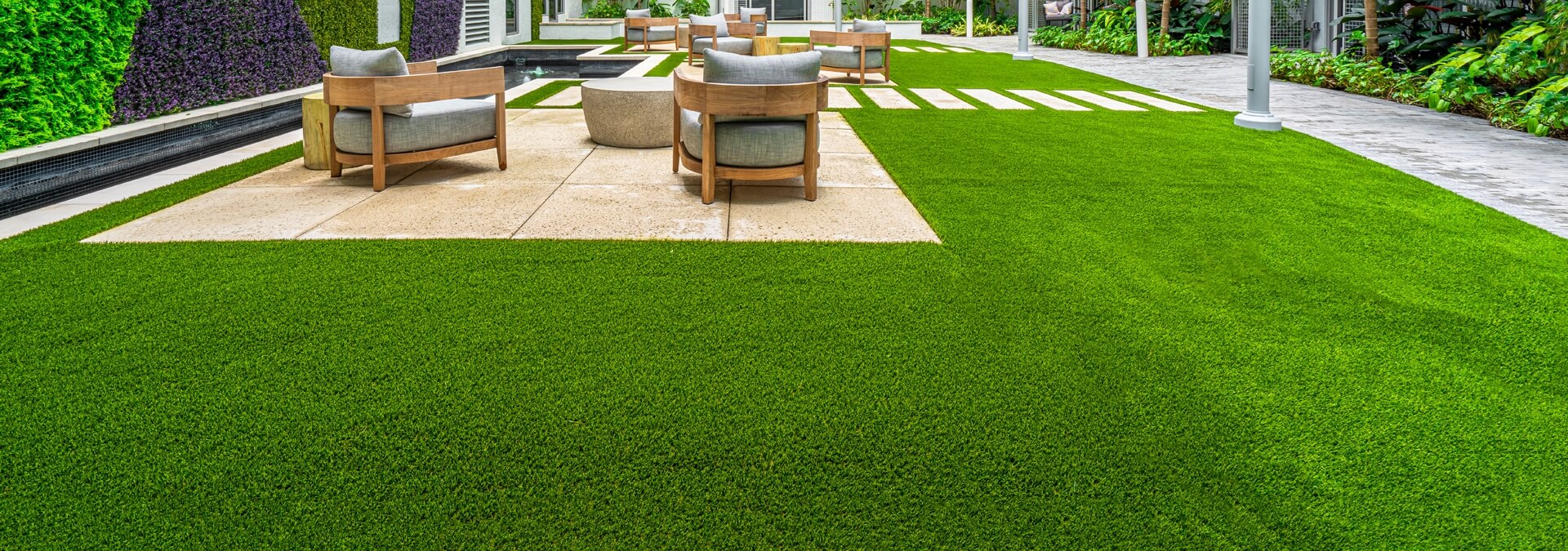Choose Reliable Artificial turf companies for High-Quality and Natural-Looking Turf
Choose Reliable Artificial turf companies for High-Quality and Natural-Looking Turf
Blog Article
How Does Synthetic Grass Setup Change Your Landscape?
The setup of artificial turf provides a diverse chance for landscape transformation, offering a blend of visual enhancement and sensible benefits. Past the immediate aesthetic allure of a constantly eco-friendly space, synthetic lawn substantially decreases upkeep demands and water usage. Its versatility enables for creative landscaping services customized to various environments, making it an engaging choice for both residential and industrial applications. The ramifications of such a makeover expand beyond simple aesthetics and comfort, motivating further exploration into the long-term effects on cost, ecological sustainability, and total landscape health and wellness.
Benefits of Man-made Lawn
When taking into consideration landscape design remedies, the advantages of synthetic lawn ended up being significantly noticeable. One of the most substantial benefits is its reduced upkeep requirements. Unlike all-natural lawn, which demands normal mowing, watering, and fertilizing, synthetic grass keeps its lavish look without these labor-intensive jobs. This allows residential or commercial property owners to designate their time and resources to other pursuits.
In addition, synthetic grass gives a constant playing surface, making it suitable for leisure locations and sports areas. Arizona artificial grass. Its toughness makes sure that it can hold up against heavy foot traffic without the wear and tear connected with natural turf, hence promoting year-round functionality
Ecological benefits also play a vital duty in the appeal of artificial grass. By getting rid of the demand for chemicals and herbicides, it adds to a much healthier community. The decrease in water use is significant, especially in locations susceptible to drought.
Furthermore, synthetic grass enhances visual allure, supplying a vibrant green landscape that stays uniform throughout the seasons. This uniformity can boost residential or commercial property value and curb appeal, making it an eye-catching option for homeowners and companies alike. In recap, the countless advantages of man-made turf make it an engaging option for modern landscaping services.
Expense Savings Over Time

To start with, synthetic grass eliminates the requirement for reoccuring expenses connected to water, fertilizers, pesticides, and yard upkeep services (Mesa artificial grass). House owners can anticipate to conserve substantially on their water bills, especially in regions vulnerable to dry spell, where watering of natural lawn can end up being excessively expensive. Furthermore, the lowered need for chemical treatments not only lowers prices but also lessens labor expenditures linked with yard care
Additionally, man-made grass is created for resilience, lasting in between 15 to 25 years with proper maintenance. This durability implies fewer replacements and repairs, resulting in additional financial savings. Gradually, the advancing economic advantages of synthetic grass can substantially outweigh the preliminary prices, making it a sensible financial investment for those wanting to improve their landscapes while also handling their budget plans effectively. In summary, the lasting expense savings related to synthetic grass make it an attractive alternative for home owners looking for both visual appeals and economic carefulness.
Environmental Effect
The environmental influence of synthetic grass is a topic of considerable passion and argument. Supporters argue that synthetic turf preserves water, as it removes the requirement for irrigation, which is particularly advantageous in arid regions. This water conservation can result in minimized pressure on local water sources and reduced utility costs for home owners. Furthermore, synthetic grass gets Get the facts rid of the necessity for chemical fertilizers and chemicals, which can position threats to local ecosystems.
Nonetheless, issues regarding the ecological footprint of synthetic grass persist. The manufacturing of synthetic products often calls for substantial energy and oil resources, adding to carbon emissions. When fabricated turf reaches the end of its life cycle, disposal can end up being problematic, as several products are not eco-friendly and can finish up in landfills (Mesa artificial turf).
An additional location of worry is the capacity for microplastics to leach into the soil and rivers, which might detrimentally impact water life and environments. Consequently, while man-made grass offers certain ecological benefits, it additionally postures obstacles that warrant careful factor to consider. Stabilizing the advantages of water conservation with the environmental impacts of manufacturing and disposal is essential for making notified landscape design choices.
Style Flexibility
Synthetic grass opens a world of style convenience, permitting property owners and landscape designers to develop visually pleasing and functional outside spaces. Unlike traditional turf, man-made turf can be customized to fit various themes, styles, and purposes, enhancing the total landscape design.
One of the main advantages of fabricated turf is its flexibility. House owners can select from a selection of appearances, colors, and pile heights, making sure that the turf enhances existing attributes and building components.

Maintenance and Long Life
With minimal upkeep needed, synthetic grass supplies a useful remedy for home owners seeking a low-maintenance landscape design option. Unlike natural lawn, which demands normal mowing, watering, and fertilizing, synthetic turf dramatically lowers the time and initiative required to maintain an attractive yard.
The longevity of fabricated grass is an additional compelling advantage. Usually, artificial lawn can last between 15 to 25 years, depending on the high quality of products used and the level of foot web traffic it endures.
Moreover, upkeep jobs for fabricated grass are uncomplicated. Occasional cleaning to maintain the blades upright, rinsing to eliminate debris, and periodic infill replenishment are typically adequate to keep its appearance and functionality. This simplicity of maintenance permits home owners to appreciate their exterior areas without the worry of comprehensive labor.
Conclusion
In verdict, synthetic turf setup considerably improves landscapes by giving a lively, low-maintenance alternative to natural turf. On the whole, fabricated lawn emerges as a sustainable and useful remedy for transforming exterior spaces into aesthetically appealing and functional environments.

In conclusion, man-made grass installation considerably enhances landscapes by giving a vivid, low-maintenance choice to natural yard.
Report this page